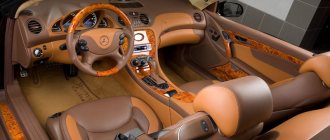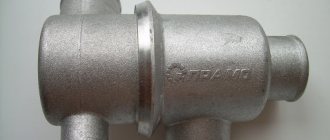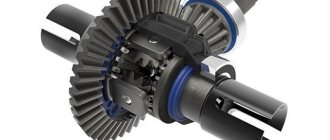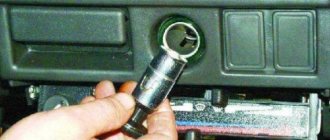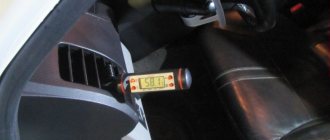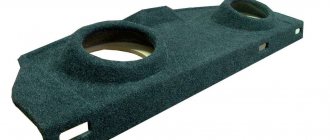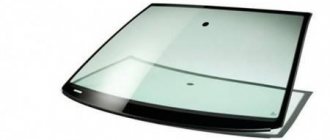Slush weather in the off-season, the appearance of cracks in the joints between parts, poor-quality dry cleaning, and spilled liquids cause the appearance of unwanted moisture in the car interior. Consequences: foggy windows and puddles underfoot are the lesser of two evils, but the unpleasant smell of mold and body corrosion are a more serious problem. How to deal with moisture depends on the scale of the disaster and the source of the problem. Among them there are some that can be easily implemented at home, and to perform some you need to contact specialists.
Article on the topic Car air conditioning: how to extend life and avoid problems
General advice for all car owners whose car contains water or other liquid inside that is not intended by the manufacturer is to drive the car into a warm, dry room and leave it there for several days with the doors and trunk open. If the time of year and weather permit, you can simply leave the car in the sun. In this case, you need to remove the floor mats, remove the seat covers and open the windows. However, not many people have such opportunities.
A simple and effective way to dry the car interior after a rainstorm
Driving in a wet car is, to say the least, not comfortable - the windows constantly fog up and it squishes under your feet. But the most unpleasant thing is that dampness provokes corrosion of the body and can also cause short circuits in the on-board electrical wiring. What to do?
The problem is that not every car owner has such a garage at hand, and even with guns. And not everyone can afford to give up traveling for a couple of days.
The most primitive method that owners of wet cars resort to is to buy baby absorbent diapers and cover everything in the cabin with them: chairs, floor upholstery, and in general all interior parts that have been damaged by water. Of course, it is possible to collect water on the surface in this way. But you won’t be able to completely get rid of dampness.
A more advanced method involves the use of all kinds of car heaters connected to the cigarette lighter. They have different designs - ranging from a “box with a fan” to “capes” with built-in heating filaments. We install such a device in the area of the cabin selected for drying and turn it on. And opening the windows slightly (so that the evaporated moisture leaves), we wait for the result. Then we repeat the procedure in another part of the machine and so on. Such devices are far from the power of an average heat gun, and therefore the process can take a week.
The most effective and simple method of drying a car interior is, as they say, on the surface, but not all car owners who find themselves in a wet interior remember it. The fastest way to dry the interior of your car is with the standard “stove”! We remove the rubber mats from the cabin, turn on the “heating” to the maximum temperature with maximum airflow in the air recirculation mode inside the cabin. We direct the air flow “to the legs”. In this case, the windows need to be opened slightly to remove moisture.
Operating a car in such conditions is problematic, but possible. But the torment is worth it: if you set a goal, then in a day you can dry your car almost dry in this way. If it’s warm and sunny outside, then it makes sense to dry it directly in the sun. The main thing is that the engine cooling system can cope with such a load at idle speed. When it rains from the sky, it is best to dry your car in this way in an underground parking lot. Finding a suitable location under the nearest shopping center is usually not difficult.
Do you want to discuss the material or express your opinion?
Do this in the comments under this material on VKontakte or Facebook!
Source
Auto magazine
It’s good if you know a carburetor mechanic. And if not? You can try to do the adjustment yourself, but for this procedure you need to know at least more information about the carburetor.
Selection of types of jets for Solex carburetor 21073
– one of the components of its configuration for the most reasonable further operation. And before changing one for another, you need to fundamentally understand: why, and what kind of detail is this?
The engine sucks air through the diffuser, and a certain amount of gasoline through the fuel nozzle. The volume of air and fuel sucked in also depends on the engine size. Therefore, the trend is to install a small jet for a larger engine volume. And if you have to install a similar Solex 21073 carburetor on a small engine (for example, 1.5), then the standard jets are poor (that is, they give an unsaturated mixture).
Therefore, we can say that it all starts with the fuel nozzle - its assembly and configuration. Afterwards, for the second time, you need to pick up an air one for it. Start strictly with the first camera until you have set it up; it is not recommended to work on the second one under any circumstances.
Rule:
We select jets according to engine volume. Before starting the installation, it is best to find a factory Solex that matches the volume of the unit on your car, and rearrange (or install the same) jets from it.
Selection Basics
If we install, for example, Solex 21041 (volume 1.8) on a 1.5 engine. This carburetor has a 24x26 diffuser, fuel volume is 102.5, which is not enough for a 1.5 engine. We are looking at the confluence of chambers and diffuser. We find the closest option: Solex 21073. It has a 24x24 diffuser and a TJ - 107.5. And the first cameras are almost identical. By the way, if the diffusers are almost the same, and the engine volume is smaller, then there will be less gasoline intake (the jet is rather poor). This means that we need fuel jets (fuel jets) from 110. Let’s get a few.
Next you need to decide
, what do you want to get: economical slowness or fast throttle response. Depending on the decision, we select the fuel mixture: to adjust it, enrich or deplete the mixture of air and fuel (a lean mixture will lead to gas savings, but will affect the acceleration dynamics of the car).
A few examples of how to choose
1.8 liter engine
. Carb – Solex 21073 (24x24). The first chamber goes fuel - 115, air - 165. In the second: TZ - 115, air (VZ) - 125. single: 41st. In this situation, the consumption of AI 92 for urban driving is from 8 to 9 liters.
Engine 1.5 D
. carb - Solex 21073. In the first - TZh 115, VZh - 155 ZD. In the second - TZh 115, VZh 135 ZC. XX - 41st. Gasoline AI 80. Consumption – highway 10, city 12.
Additional Information
In general, in addition to the selection of jets, there are a lot of useful and interesting nuances of setting up the Solex, so that it works correctly and connects to the engine of your carburetor car.
You should always start by setting the levels in the chambers. They are installed manually with the positions of the floats themselves depending on the unit cover (everything is done according to special templates). And in vain you think, like many gullible Solex users, that everything is already on display from the factory. To avoid overflow and stress on the needle, we make the appropriate adjustments by bending the float tongues.
Read the article for more details
“How to set the fuel level in a Solex carburetor.”
After setting the levels, you can start idling. It depends on the position of the screws for the quality and quantity of the mixture (torsion should be performed with the suction removed).
Of course, it is clear that there is no limit to improvements. Sometimes they can even go to excess: drilling, for example, a throttle valve, polishing an MD, soldering epulsion tubes on a carburetor. But, as they say, what is in excess is unhealthy. But such a procedure, fascinating in its own way, like selecting the types of jets for a Solex 21073 carburetor, for example, is a very necessary thing for the correct installation of the unit and its full compatibility with the engine compartment. As a result, you will get an economical car that responds well to gas.
Five ways to get rid of water on car mats
To minimize the amount of snow and potentially water in the cabin, all you need to do is arm yourself with a brush or broom, which is logical to keep in the door or door pockets if the driver is not alone in the cabin.
It will take you 5-10 seconds to brush away the snow before boarding, and you will eliminate the scenario where the melted water begins to evaporate as the cabin warms up, causing the windows to fog up.
For the winter period, it makes sense to replace standard car mats with special ones, which are called “car diapers”. This is a reusable product with a universal (rectangular) shape, consisting of a polymer antistatic mesh with hollow cells.
Such a mat is capable of absorbing up to 2 liters of liquid, preventing moisture, dirt and reagents from reaching the floor covering of the car and at the same time keeping small pebbles and sand on the surface. In case of heavy contamination, the diapers are lifted, held vertically by the corner and shaken.
If your mats are not fabric, but rubber, it makes direct sense to “tune” them in such a way that the melted snow is absorbed into an additional layer that “homemade” people can make on their own.
A couple of newspapers are best. A standard A3 spread can absorb up to 150 ml of water in a short time.
However, the “newspaper” method, whatever one may say, is not the most aesthetically pleasing. On the Internet you can find advice from “experienced” people who successfully use baby absorbent diapers for similar purposes (about 100 rubles per ten).
One such diaper is enough for about 5 trips. In our opinion, it is even more convenient to throw special absorbent rags onto the rubber mat for washing the car. After each trip in the snow, all you have to do is squeeze them out.
Some motorists use silica gel or gel cat litter to dry the interior floor. The granules are collected with a vacuum cleaner.
If water does spill out of the carpet, measures should be taken to dry the carpet in order to eliminate the unpleasant odor and potentially corrosion and rotting of the carpet.
Finally, you can simply leave the car windows or doors open in a warm garage, and the problem will solve itself within a day. Well, if we are talking about serious flooding, then you need to go to a car wash or service center, where the interior will be dried using special equipment.
Source
Factors causing increased humidity in the cabin
Adverse weather conditions
Due to rain or other precipitation, there may be passengers wearing damp outerwear and shoes in the cabin. Liquid that gets in this way is usually eliminated by turning on the climate control systems. In this case, you need to block the access of air from the external environment (if the machine is equipped with air conditioning, then you need to turn on the recirculation mode) and periodically change the temperature conditions, adjusting the temperature in contrasting values. During such procedures, excess moisture may form as sediment on the windshield. The glass must be treated with a microfiber cloth to remove any remaining liquid.
Water inside the car after rain may remain on the rubber floor mats. To dry the car interior under the mats, it is better to lay out an impregnating layer in advance (you can use rags or old newspapers). The main thing is not to forget to remove it from the cabin in time.
Car build quality
As a rule, this problem is typical for budget cars. Poor fit of body elements or seal parts creates gaps through which moisture penetrates into the interior. The problem with body sealing can be corrected by replacing the sealing layers or applying a sealing paste.
Flooding of a vehicle
If you delay or ignore these procedures, the upholstery of the cabin and seats may begin to rot, an unpleasant odor will appear in the cabin, and pockets of mold will appear.
Visiting a car wash
Water may remain in the interior after poor dry cleaning of the interior. The car floor and seat cushions must be covered with absorbent material. It is better to press down the absorbent layer with heavy objects in order to speed up the process of removing moisture. You can then use portable heaters or heat guns to warm the interior with dry air. After warming up, you need to re-lay the absorbent layer to make sure that the moisture is removed. It is imperative to treat the lower segment of the seat backs, because the bulk of the moisture is concentrated there.
Gaps between body elements
If you notice that the floor upholstery, counters or shelves located under the glass become wet even with slight precipitation, it means that the interior has lost its airtightness.
Often the reasons for such untidy consequences are poor-quality assembly or worn-out seals. To eliminate these phenomena, it is worth replacing outdated parts or using a sealant. And you can remove excess moisture using any method already described.
Other tips
In order to properly dry the car interior, it is important not to forget to remove excess items from the interior and trunk. The car should be as empty as possible. It is necessary to remove the seat covers, dismantle the child seats, and remove the rubber mats. In case of severe flooding, after drying the upholstery and seats, it is necessary to inspect the cabin air filter and the air conditioner filter.
If they are wet, they can be dried at home. If there are contaminants in the filters, these components will need to be replaced. Do not store wet things in the cabin . If it is not possible to remove them from the car, then you need to place them in a sealed bag or container.
Source
Actions to take when the floor is very wet
In case of more global flooding of the interior, for example, when the car has scooped up water from a deep puddle or dived into a body of water, the problem cannot be solved by the methods discussed. If you can drain the main water yourself, then for complete drying it is better to use the services of professionals, since in this case you cannot hesitate. The longer the interior is in contact with water, the higher the likelihood of moisture penetrating into the noise and heat insulation layers of the upholstery. In addition to worries about removing water from the floor, in this case you will have to disassemble the upholstery for subsequent drying. This will require a lot of time and space where the materials will need to be dried, but if everything is done correctly and quickly, then the appearance of mold, the unpleasant smell of dampness and other related problems can be avoided.
Slush weather in the off-season, the appearance of cracks in the joints between parts, poor-quality dry cleaning, and spilled liquids cause the appearance of unwanted moisture in the car interior. Consequences: foggy windows and puddles underfoot are the lesser of two evils, but the unpleasant smell of mold and body corrosion are a more serious problem. How to deal with moisture depends on the scale of the disaster and the source of the problem. Among them there are some that can be easily implemented at home, and to perform some you need to contact specialists.
General advice for all car owners whose car contains water or other liquid inside that is not intended by the manufacturer is to drive the car into a warm, dry room and leave it there for several days with the doors and trunk open. If the time of year and weather permit, you can simply leave the car in the sun. In this case, you need to remove the floor mats, remove the seat covers and open the windows. However, not many people have such opportunities.
What to do if the interior of the car is flooded with rain
To flood the interior of a car and end up practically drowned, it is not at all necessary to experience river fords or try to overcome lowlands that are flooded with water. Sometimes it is enough to not fully raise the windows when leaving the car in the parking lot. Rainy weather knows its job, and does it quickly.
Car flooded after rain
There are no easy ways to find a wet car interior if you discover it in the morning. You should immediately tune in to serious work to eliminate obvious possible consequences. The first step is to dry the interior so that you can climb into it and sit down. This means that the first thing you need to do is remove moisture from the seats. But the first steps are to scoop up the water that is on the floor, remove all the rugs, and turn on the stove to maximum (recirculation and the strongest airflow). We direct the reflectors downwards, the windows should be slightly open so that excess moisture has somewhere to go.
What harm does water cause in the cabin?
Do not expect that the car will recover in an hour or two; working in this mode, the interior will become more or less suitable for normal living during daylight hours. If after this incident you decide to get rid of your car, then this procedure will give you peace of mind. However, if you are not going to sell, then there is still a lot of work to be done. But the point here is that the insidiousness of water lies in its ability to penetrate into all hidden cavities, under upholstery, under panels, under decor, etc. Of course, this is not fatal in itself, and body parts of modern cars undergo special treatment (cataphoretic primer). There seems to be nothing to worry about, except that the wet places will start to rot and there will be an unpleasant heavy smell in the car.
What harm does water cause in the cabin?
However, there is still a problem, since hidden cavities and niches are usually used by automakers for laying various types of communications, electrical wiring, control cables, etc. And these are connections, connectors, the plugs of which get water, as a result of which the metal begins to corrode, the contacts oxidize. When the interior is flooded, such problems affect more than one plug, and this automatically places the car in the disabled category, since the entire remaining life of the car will be constantly haunted by implicit, elusive glitches in the electrical and electronics system.
What to do if the interior is flooded
What to do after interior flooding
The best option will always be to take your flooded car to a reliable car service center, where qualified professionals know what to do in such cases. They will disassemble the car piece by piece, blow each part with compressed air, dry all the wires and all contacts with a hairdryer, and then put it back together, not forgetting to treat the necessary areas with an anti-corrosion compound. If you have the necessary equipment in the garage and you know how to use a screwdriver and keys, then you can carry out this operation yourself. No matter how tedious and difficult it may be, not a single niche, cavity, contact or wiring should be missed. And remember, moisture can damage the airbag (side) connectors, and this is a serious safety violation.
When might you need to dry your car?
It is necessary to dry the car if the windows constantly fog up and become covered with frost from the inside. This is the first sign that there is high humidity inside. Drying the car interior be put off for too long . Delay will only make the problem worse.
Due to dampness, clothes and shoes deteriorate, pockets of corrosion appear on metal parts of the body, an unpleasant odor appears, and short circuits in the electrical network are possible. The main danger of high humidity in the car interior is the development of mold, the inhalation of spores of which can lead to diseases of the respiratory system.
Where does dampness come from?
Drying the car may be necessary if moisture accidentally gets into the interior:
The second way dampness occurs in a car is associated with standard maintenance procedures:
If the drying of the car interior after these steps is performed poorly, residual moisture will penetrate into the upholstery, insulation and sound insulation.
These porous materials quickly absorb water, and it is very difficult to extract it from them. We have already talked about how harmful dampness in a car is.
The cause of moisture usually resolves quickly
The problem with moisture appearing in the car is easily explained. During cold or humid periods of the year, fog (moisture in the air) quickly begins to condense in the car, and all due to a drop in the air temperature itself.
When the air temperature begins to drop. As a result, the moisture in the air begins to settle on the cold car windows. And what’s unfortunately bad is that this moisture that gets into the car won’t be able to get out of it so easily.
Another reason for the formation of moisture in the car is its irregular maintenance. Yes, yes, don’t be surprised if you treat your car without proper attention, then later you will simply get tired and exhausted in dealing with the excessive formation of moisture in the car showroom. But these problems can also be easily eliminated.
For our part, we have collected for you (motorists) the most useful and necessary tips that will help you overcome annoying humidity (dampness) in the interior of your car. You can carry out (do) most of the methods and operations for removing moisture from the interior of your car yourself, unless you already need to change the rubber seals in your car, or the sunroof, etc. difficult work for you, where, most likely, you will need qualified assistance and possibly considerable financial investments.
And so, we present a list of all the main ones.
Professional non-contact car drying
Non-contact drying of the car interior is used as one of the means of combating high humidity . There are technologies for evaporating water using a stream of heated air and using heating lamps. These methods were originally developed for drying the outside of a car body. In practical application, it turned out that the technology can be successfully used to treat car interiors.
Air drying
Reputable car repair shops have special equipment for drying the car with air after washing . These are devices that generate a strong directed flow of heated air. They are often called turbo dryers.
Drying a car with air is used after washing to remove water from the cracks at the joints of body parts, door frames and hood. If necessary, you can use turbo dryers to dry the interior. The duration of the operation depends on the amount of fluid accumulated inside the car.
By the way, you can buy a turbo dryer for personal use and perform contactless drying of the car yourself. It's comfortable. The only drawback is the high cost of the equipment. The price of a turbine dryer is from 10 thousand rubles.
Quartz car drying
It is more correct to call this technology infrared drying. Quartz car drying lamps emit short-wave infrared radiation. Infrared waves penetrate loose materials and heat the metal. As a result of such exposure, moisture-saturated layers of sheathing, insulation and sound insulation are dried from the inside.
This technology is designed to speed up drying after painting a car . Temperature exposure reduces the polymerization time of the paintwork. At car services, this equipment is successfully used to dry car interiors after dry cleaning or wet cleaning.
Professional dryer drying
If the car interior has been dry cleaned, drying with a hairdryer is included in the standard list of procedures. This technology is designed specifically to remove moisture from porous and loose materials. The result is simply excellent. On average, it takes about two hours to completely dry a car using this method.
A professional auto hair dryer for drying car interiors is a set of a workstation with hoses and special covers. The stationary part is an electric heat gun in a durable housing with outlet pipes for supplying heated air. Covers of various shapes are used to dry the seats and floors.
Today, drying the car interior with a hair dryer is the most effective option. The disadvantage is the relatively high cost of the service. To dry all the seats and the floor in the cabin, you will have to shell out about two thousand rubles. If you also need to remove moisture from the trunk, you will need to pay another half of this amount.
None of the products that are used today in car services can compare in convenience and quality with a hair dryer. As always, you have to pay for comfort and speed. Literally. With money. For example: the price of a CarFon hair dryer from the famous manufacturer Bieffe (Italy) is about 60 thousand rubles. You cannot buy such a device for personal use.
How to get rid of smell in your car
There are several ways to get rid of unpleasant odors in the car interior, using special chemicals or home remedies. Before treating the interior, you should check every corner of it, determine the cause of moisture and mold - it is possible that simply drying the upholstery and rugs will be enough to forget about odors.
Baking soda
Sodium bicarbonate cleans and disinfects fabric surfaces in the car interior well. Sprinkle soda on the seat upholstery and rugs, leave it overnight, and the next day you just need to vacuum the interior.
Important! Soda is not suitable for coatings made of plastic and leatherette!
Activated carbon
Coal is an ideal absorbent that perfectly absorbs moisture and odors. It is enough to scatter 5-10 tablets of activated carbon in the cabin, and the odors will disappear. To avoid staining the upholstery, charcoal is poured into fabric bags and placed in the glove compartment, under the seats, and in door pockets.
Vinegar
Vinegar, diluted with water in a ratio of 1:2, is used to wipe surfaces in the car interior. Excess moisture should be removed immediately after wiping with a dry cloth. The doors to the salon must be open, and after treatment, the car must be ventilated.
Ammonia
Ammonia perfectly disinfects rugs, destroying mold. For treatment, ammonia is diluted with water, 15 drops per 100 g of water. Then pour the resulting composition into a spray bottle and spray it on areas where mold accumulates. To avoid intoxication, the doors are kept open, and after the procedure is completed, the car is ventilated.
Best answers
open all the doors and on one side a couple of heat guns. let the interior be blown with hot air..
start the car and leave the interior to warm up, the heat will dry it out, dry it often every day
just lifting the “carpets” and installing an electric heat vent in a day or two will help. Or wait for summer and a week of vacation with open doors and a good draft. Especially in foreign cars there are a lot of foam rubber and other thermal vibration and noise insulation and it is very difficult to evaporate moisture
I agree with Vitaly, you need to remove the carpets and first wash everything and wipe it dry (if possible) and leave the heater in the cabin for a long time
It would be good to first use a washing vacuum cleaner to collect as much moisture as possible, as well as dirt. Then a heat gun. Another tip - in hard-to-reach places you can collect moisture with diapers or, sorry, pads.
If the car floats
After a serious immersion in water, the first thing to do is open the drain holes or manually scoop out the remaining water. Then there are two options: either disassemble all the upholstery yourself and dry its layers, or go to the car wash.
If the flooding occurs while the engine is running, it is likely to be submerged in water and must be rescued immediately. The first step is to dry and clean the interior of the car. Do not start the vehicle: water entering the engine system can damage the vehicle.
It is necessary to inspect all parts of the car. Look for water inside the doors and in the taillights, carpets and trim. This will allow you to eliminate the need to clean certain parts or systems of your vehicle.
Before drying the car interior from water, it doesn’t hurt to temporarily remove the seats. Unfortunately, there is no guarantee that the water has not caused irreversible changes in the structure and shape of the finishing parts, which, after drying, lose their properties, and they will only be suitable for disposal. In addition, water carries various contaminants that enter the interior, so in addition to drying, you must give everything a good cleaning.
Under the covering of the chairs on the floor there is a special material (like a foam sponge), which is a sound-proofing layer. If your car gets wet, it will absorb a lot of water. This is why you need to squeeze this material out and dry it for quite a long time.
How to dry the car interior from water? Remove the car floor mats, dry them thoroughly with towels or rags, then hang them up and leave them to dry completely. If the entire interior carpet is wet, use a washing vacuum cleaner to remove at least some of the moisture, and then dry the carpet using fans, a hairdryer, a heater or other equipment.
If the weather is warm and dry, leave the car for several hours with the doors wide open. If the air temperature is not high enough, remove the trim wherever possible, open all windows 2-3 cm, turn on the heater and leave the car for 2-3 hours. In addition, powerful fans can be used to dry the interior.
Check the cabin air filter. It seriously absorbs condensation and accumulates it. It often harbors mold and mildew. So it’s better to remove it, dry it and put it back in place. If it is severely damaged and contains a lot of debris, then it should be replaced with a new one.
If water has leaked into the engine and transmission, you need to change the oil and filter before starting the engine. Cloudy water or dirt should be removed from the engine oil pan and thoroughly washed. When drying a flooded car, it is imperative to wash the air ducts of the interior ventilation. Otherwise, the bacteria accumulated there from rainwater will subsequently begin to multiply and transfer the unpleasant smell of mud into the interior.
How to dry the car interior from water? To dry the “drowned” interior, ideally you need to drive the car into a warm and well-ventilated garage. Open all the doors and point a couple of heat guns inside the cabin. A day or two in this mode and the car will be dried.
If parts of electrical equipment get wet during a car flood: low-mounted switches, electronic units hidden under seats, electronic gas pedal, etc., you should contact specialists at a service station, even if no failures have occurred. Water can cause corrosion or oxidation in electrical appliances and their terminals, which will only make themselves felt after some time.
Technology and stages
The cleaning process should be carried out in stages so that the next stage of washing does not harm the result of the previous one. An approximate work plan could be like this:
- Ceiling.
- Seats.
- Plastic.
- Door covering.
- Floor.
- Trunk.
- Glass.
The order of operations on this list may vary due to differences in vehicle designs.
Ceiling
Car enthusiasts recommend starting cleaning from the ceiling of the car, so as not to end up with litter on other parts of the car. The surface of the ceiling is visually divided into four sectors, onto each of which a foam substance is applied in turn. Spaces are not allowed. After 5-10 minutes, the cleaner will draw out the dirt and it will be removed with a clean cloth. The remaining areas are processed in the same way.
When cleaning, movements of the fabric must be made in the same direction (for example, from the windshield to the rear), with such manipulations there will be fewer streaks when drying.
Seats
As mentioned above, if this is possible, it is better to remove the seats and clean them separately. The procedure is the same as when treating the ceiling - the cleaning composition is applied to the surface of the material, and after 10 minutes the released dirt is wiped off with a cloth. After several movements, the napkin should be rinsed in a bucket of water and squeezed thoroughly.
Plastic areas
Smooth plastic panels are cleaned with the same chemicals. To do this, use a soft sponge for washing dishes: the substance is applied to the plastic and wiped off with several movements of the sponge. Textured plastic can be washed with microfiber. When cleaning the front panel, it is better to remove the equipment (radio tape recorder, navigator, etc.), and seal the places where they are installed and where the power is connected with tape.
Doors
The inner surface of car doors most often consists of fabric inserts, plastic sections, and devices for controlling glass lifting and opening. You should start cleaning this element of the machine with the fabric parts, onto which detergent is applied and then wiped with dry microfiber.
After this, the plastic parts of the doors are processed - the foam composition is applied for several minutes and wiped with a cloth. The door release lever, keys or window handles are carefully washed with a sponge to prevent liquid from flowing into the internal cavities.
Floor mats removed from the interior before dry cleaning are washed separately with a soap solution. The floor and the area under the seats are cleaned with detergent and a brush. In case of heavy contamination, the operation is repeated several times. If you cannot remove the seats, you need to try to reach as deep as possible under them with a brush of a suitable shape.
Trunk, windows
The trunk, emptied of all things, is thoroughly cleaned of accumulated debris of various origins with a powerful household or car vacuum cleaner. After this, the fabric parts are washed with a foam composition, and the plastic elements are wiped with napkins soaked in a cleaning solution.
Special cleaners are used to clean glass. These substances are sold in car dealerships in a huge assortment, but their operating principle is the same - spray on glass and wipe with a cloth after a few minutes.
Drying
After finishing the work, the interior must be thoroughly dried. In the summer heat, this is not a problem outdoors - the sun's rays will dry the car in a few hours better than any heater. But in the garage, especially in winter, you can speed up the process using a household hair dryer or air heater. In this case, you must be careful not to damage the coating of the interior parts with hot appliances.
Independent dry cleaning of the car interior is possible with high-quality preparation for it. But when servicing an expensive car, it is better not to skimp on this procedure and contact a professional organization.
Subscribe to our feeds on social networks such as Facebook, Vkontakte, Instagram, Pinterest, Yandex Zen, Twitter and Telegram: all the most interesting automotive events collected in one place.
Dive
Often, drivers are faced with the fact that a lot of water can get into the car interior. The reasons are trivial, ranging from a broken flask to overcoming large puddles.
Initially, we drain the remaining water by opening the provided technological drain holes or simply by scooping up water. Prolonged contact of liquid with interior elements will lead to its absorption into heat and sound insulation, as well as other porous materials.
In this case, you will have to remove the upholstery and thoroughly dry all the layers, but this will require a lot of time and free space.
Source
Puddles on the floor
In snow or rainy weather, water and dirt are carried into the interior on shoes. If you do not shake off the excess before planting by tapping your feet together, then at some point the liquid may seep under the mat through the fixing holes or in the area of the jammed edge. To reduce the consequences, you need to put newspapers or absorbent sheets, or special rugs under your feet. The main thing in this method is not to forget to periodically throw away the soaked materials. If it’s frosty outside, it’s better to do it while the interior is warm. Otherwise, frozen newspapers or sheets tear, and cleaning them becomes a separate problem.
Photo: www.globallookpress.com

